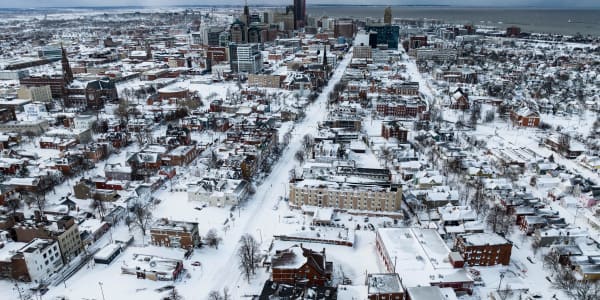America is facing an unprecedented jobs crisis that is also different from anything government record keepers have seen before. This time it is not the jobs that are in short supply; it is the workers. Employers posted a record 6.7 million job openings as of the end of April, according to the U.S. Bureau of Labor Statistics. But the same agency says only about 6.1 million people are unemployed, meaning that for the first time since the government began compiling data on job openings in 2000, there are more openings than there are people to fill them.
But some states are managing to bridge this so-called skills gap, offering plenty to smart employees ready and willing to work. Workforce is the most important category in CNBC’s exclusive America’s Top States for Business study, worth 425 out of 2,500 points. We put each state’s workforce through its paces based on the data. We look at the number of available workers and which states are doing the best to attract them. We look at how educated they are. We examine which states have a Right to Work law, which affirms the right of every American to work for a living without being compelled to belong to a union and pay dues. To find states with the nation's top talent we measure in-demand science, technology, engineering and math (STEM) skills, state worker-development programs, union membership and more. Here are the leaders:
10. Michigan
The Wolverine State might be thought of as a Rust Belt manufacturing state, but the automotive industry that earned Michigan that reputation is a magnet for skilled workers. Few states can boast a higher concentration of STEM workers, and we are not talking only about automotive engineers and technicians. The state’s workforce training programs are among the most effective in the country. The birthplace of the United Auto Workers is still a big union state, but the adoption of right-to-work legislation in 2012 has drawn praise from business.
2018 Workforce score: 278 out of 425 points (Top States Grade: A-)
Unemployment (May 2018): 4.6 percent
Adults with bachelor's degree or higher: 27.4 percent
Workers in STEM occupations: 7.3 percent
Right-to-work state? Yes
9. North Carolina
The Tar Heel State practically invented the idea of “If you build it, they will come” when it created the famed Research Triangle Park between Raleigh, Durham and Chapel Hill in 1951. Today North Carolina remains a magnet for skilled workers. The state is a leader in attracting and retaining educated workers, and the fact that unemployment is above the national average means there is a plentiful supply of those good, smart candidates to choose from.
2018 Workforce score: 281 out of 425 points (Top States Grade: A-)
Unemployment (May 2018): 4.3 percent
Adults with bachelor's degree or higher: 34.4 percent
Workers in STEM occupations: 6.2 percent
Right-to-work state? Yes
8. Arizona
People have been flocking to the Grand Canyon State for years, and it turns out that a great many of them are well educated. In 2016 alone, Arizona attracted some 67,000 new residents with bachelor’s degrees or higher, according to the Census Bureau. And relatively high unemployment means plenty of those people are available for work. Arizona@Work is the state’s workforce development program, with policymakers, educators and employers coming together to better match training with the needs of business and industry.
2018 Workforce score: 285 out of 425 points (Top States Grade: A)
Unemployment (May 2018): 4.7 percent
Adults with bachelor's degree or higher: 28 percent
Workers in STEM occupations: 6.7 percent
Right-to-work state? Yes
7. Texas
Workers in the Lone Star State are among America’s most productive, according to government statistics. On average, each Texas worker accounted for about $122,000 in economic output last year. Rising oil prices have helped that number somewhat, but the Texas economy is increasingly diverse, employing a healthy percentage of STEM workers. The economic upturn in the state has lowered unemployment, reducing the pool of available workers. Still, the Texas workforce is world class.
2018 Workforce score: 286 out of 425 points (Top States Grade: A)
Unemployment (May 2018): 4.1 percent
Adults with bachelor's degree or higher: 29 percent
Workers in STEM occupations: 6.3 percent
Right-to-work state? Yes
6. Maryland
The Old Line State certainly has a line on brain power. Here you will find Johns Hopkins University, the bustling tech corridor between Baltimore and Washington, D.C., and the suburbs of the nation’s capital. No wonder Maryland boasts the highest concentration of STEM workers in the nation.
2018 Workforce score: 287 out of 425 points (Top States Grade: A)
Unemployment (May 2018): 4.3 percent
Adults with bachelor's degree or higher: 38.4 percent
Workers in STEM occupations: 9.3 percent
Right-to-work state? No
5. Colorado
The Centennial State boasts one of America’s best-educated workforces and a strong worker training program. Colorado has been working hard to develop the next generation of high-tech workers in the state. Colorado STEM is a coalition of business, education, and civic leaders developing science, technology, engineering and math experiences for students of all ages. The state would likely rank higher in the category were it not for low unemployment putting skilled workers in short supply.
2018 Workforce score: 295 out of 425 points (Top States Grade: A+)
Unemployment (May 2018): 2.8 percent
Adults with bachelor's degree or higher: 38.7 percent
Workers in STEM occupations: 8.7 percent
Right-to-work state? While not technically a right to work state, Colorado’s Labor Peace Law is a compromise statute that sets high barriers to unionization.
4. Georgia
The booming Georgia economy is attracting a steady influx of educated workers. The Peach State was hit hard during the Great Recession. During the recovery, the residual high unemployment left the state with a large pool of available workers. Today, unemployment is only slightly above the national average. So while Georgia still has an advantage on workforce supply, that edge has dwindled somewhat.
2018 Workforce score: 296 out of 425 points (Top States Grade: A+)
Unemployment (May 2018): 4.2 percent
Adults with bachelor's degree or higher: 29.4 percent
Workers in STEM occupations: 6 percent
Right-to-work state? Yes
3. Virginia
The Old Dominion is brimming with talent. Virginia has one of the best-educated workforces around and one of the largest concentrations of STEM jobs. Employers like the fact that it is not a big union state. Where the state falls short, though, is in worker supply. Its 3.2 percent unemployment rate is one of the lowest in the country.
2018 Workforce score: 304 out of 425 points (Top States Grade: A+)
Unemployment (May 2018): 3.2 percent
Adults with bachelor's degree or higher: 40 percent
Workers in STEM occupations: 8.7 percent
Right-to-work state? Yes
2. Washington
With the fastest-growing economy in the nation and a plethora of well-known employers, workers are flocking to the Evergreen State. And they are being productive when they get here, with each Washington State worker accounting for about $128,000 in economic output last year, on average. Washington workers are tech-savvy — this state has the second-largest concentration of STEM workers. And with unemployment well above the national average, those smart workers are plentiful. This is a big union state, though the presence of Boeing’s manufacturing operations likely skews that number a bit.
2018 Workforce score: 305 out of 425 points (Top States Grade: A+)
Unemployment (May 2018): 4.7 percent
Adults with bachelor's degree or higher: 34.5 percent
Workers in STEM occupations: 9.2 percent
Right-to-work state? No
1. Massachusetts
The Bay State is about as close to workforce nirvana as a state can get. Massachusetts workers are among America’s best educated. A great many of them find employment in STEM occupations. For those who don’t or are in need of an additional edge, the state’s workforce training programs are the most effective in the nation. The workforce ranks in the top 10 for productivity. And while Massachusetts is not a right-to-work state, union presence is relatively small.
2018 Workforce score: 312 out of 425 points (Top States Grade: A+)
Unemployment (May 2018): 3.5 percent
Adults with bachelor's degree or higher: 41.2 percent
Workers in STEM occupations: 9 percent
Right-to-work state? No






